VVAM Newsletter 64 – 1996
FRIENDS OF THE AIRBORNE MUSEUM
Editors:
Drs. R.P.G.A. Voskuil
C. van Roekel
G.H. Maassen jr.
Newsletter No. 64, November 1996
Translated by Cathrien and Peter Clark
Representative in Great Britain: Mr. E.E. Shaw, 298 Totnes Road Paignton – Devon TQ4 7HD Tel. 0803-553616
Ted Shaw does it again
As in previous years, parachutists from the 10th Battalion, The Parachute Regiment, carried out a parachute drop onto Ginkel Heath near Ede during the 52nd commemoration of the Battle of Arnhem. Once these 200 servicemen were on the ground there followed a parachute descent by a number of Arnhem veterans. Among these men daring once more to take up the challenge, whose ages vary from 70 to 82 and who made the jump linked to a ‘tandem¬master’, was again our British representative Mr Ted Shaw, MC. We extend our hearty congratulation to Ted on this magnificent achievement!
Ted laid a wreath at the ‘Cross of Sacrifice’ during the memorial service at the Airborne Cemetery in Oosterbeek on Sunday morning, 22 September 1996. He was accompanied by two schoolchildren from the Renkum municipality. For the last few years the wreathlaying has been carried out by George Gatland, but unfortunately ill health prevented George from attending this year’s commemoration.
Theme day on Sunday 15 December
The traditional theme day for society members will be held again this autumn. This year it will be on a Sunday so that those who have to work on Saturdays have a chance to attend; the date, 15 December next.
The programme is as follows:
11.00 hours: reception with coffee in the Airborne Museum in Oosterbeek, after which the new storage space beneath the Hartenstein terrace will be open for inspection. The storage room was partially financed by our society. At the same time the museum’s library and archives will be open (opened especially for the occasion no less!) to visitors.
Around midday lunch may be taken at one’s own expense.
13.30-14.00 hours: reception of members for the afternoon programme in Zalencentrum ‘Lebret’, Lebretweg 51 in Oosterbeek. This programme centres entirely on the film ‘A Bridge Too Far’, made in the summer of 1976.
14.00-15.00 hours: lecture by Robert Voskuil, with slides, on the making of the film. The speaker was given a special pass by the staff of producer Joseph Levine, which allowed him free movement around the film sets and the freedom to take photographs. This resulted in a large collection of slides, a selection of which has been chosen for tliis presentation. Among the slides to be seen will be those taken in Deventer and Zutphen, at Huize’t Schol (where the Hartenstein headquarters was reconstructed), at the Nijmegen road bridge, at Ginkel Heath, in Bronkhorst (where Oosterbeek church and the Ter Horst family home was ‘built’) and on the Garderense Heide.
15.00-15.45 hours: break.
15.45-16.45 hours: a showing of the British documentary film ‘The Arnhem Report, the making of ‘A Bridge Too Far’.
17.00 hours: end of the theme day.
The video ‘A Bridge Too Far’ is still widely available and it is perhaps a nice idea to do a bit of homework and watch the film again as preparation for the theme day!

21 September 1996. This year’s ‘Leader of the Pilgrimage’, Major T.l.J. Toler, congratulates a number of veterans on their successful parachute jump at Ginkel Heath.
(Photo: Berry de Reus)
Message from your UK representative
Thank you for your support of tire Friends and for your generosity.
A kindly reminder that subscriptions are due on the 1st of January 1997. Donations are always welcome. Signed
Ted Shaw, UK representative.
Second excursion to England, 2 to 6 April 1997
We have received news from Colonel Middleton, controller of the Airborne Forces Security Fund, that an army building in Aidershot will be available from the 2nd to the 6th of April 1997 as accommodation for the second excursion to England. All members who had written-in for the first excursion, but were unlucky, will be asked if they are interested in going on the second trip.
Members who did not previously apply for a place can now do so by letter. If there are seats over in the bus, participants will be chosen by lottery.
Further information will be included in the next Newsletter.
General Hackett presents his wristwatch to the museum
General Hackett recently presented the Airborne Museum ‘Hartenstein’ with the wristwatch that he has owned for 55 years and which he wore during the Battle of Arnhem. Hackett obtained the timepiece in 1942 while stationed in Palestine. It was still in use until a short time ago.
Airborne Museum commemorative envelope
The Airborne Museum has begun issuing a new series of commemorative envelopes with ‘Monumenten van de Slag om Arnhem’ (Monuments of the Battle of Arnhem) as their theme. The first edition shows the Airborne Monument in Oosterbeek, designed by the Oosterbeek architect H.W. Wesselink. The monument was made by sculptor Jacob Maris and was unveiled on 17 September 1946 by Queen Wilhelmina.
The first 400 from the 1,000 numbered envelopes have been franked with a 90 cent Operation Market Garden commemorative stamp from 1994. The rest bear the 100 cent stamp that was issued this summer. They are for sale in the Airborne Museum at 6 guilders each.
Plaque for Baskeyfield, VC
On Friday 20 September 1996, a plaque was unveiled at the corner of Benedendorpsweg and Acacialaan in Oosterbeek in memory of John Daniel Baskeyfield (2nd Bn, The South Staffordshire Regiment). Baskeyfield died here on 21 September 1944. He was later awarded a posthumous Victoria Cross. The initiative for this memorial was taken by Mr Th. Peelen from Rheden, one of our members. During his speech he recalled the dramatic events that took place 52 years ago at this spot, which is now marked by a beautiful tree. After the speech a veteran from the above mentioned battalion unveiled the plaque, which carries the regimental emblem and the text ‘Jack Baskeyfield Tree, 20 September 1996’.
 Sadly, the weather left a little to be desired during the memorial service at the Airborne Cemetery on 22 September Inst. Girls from the Koninklijke Harnionie use plastic bags to protect their clarinets from the rain. (Photo: Berry de Reus)
Sadly, the weather left a little to be desired during the memorial service at the Airborne Cemetery on 22 September Inst. Girls from the Koninklijke Harnionie use plastic bags to protect their clarinets from the rain. (Photo: Berry de Reus)
50th Airborne Walk
The 50th Airborne Walk took place on 7 September 1996 in ideal weather conditions. Among the 35,000 plus participants were 22 people who have taken part in every walk since 1947, including our Board member Chris van Roekel.
A video has been made to mark the occasion of this jubilee walk documenting its history. After looking back at the Battle of Arnhem, the video goes on to show how the first walk of 49 years ago, in which 1,700 people took part, has grown into the biggest day walking event in the world. With the aid of unique historical film the makers give a picture of the event over the years, and include interviews with people who have been closely involved. It closes with an impression of the 50th walk.
The first copy of ’50 Jaar Airborne Wandeltocht, een hele afstand’ (50 years Airborne Walk, quite a distance) was presented to Mr P. Vos, chairman of the Police Sports Association ‘Renkum’, on 11 October last.
The video is on sale in the Airborne Museum, price 30 guilders.
Can anyone help?
The editors have received a letter from England from George Barton, ex-Sergeant in No. 2 Anti-Tank Platoon, Support Company, 7 KOSB. George recently became a member of the Society of Friends and, while looking through some back numbers of the Newsletter, came across a photo on page 3 of Ministory No. 42.
It shows a Signa! Sergeant whom the author of the Ministory believed belonged to the Recce Squadron. However, George has identified the man as being Lance Sergeant Frank Hooper from Birmingham, who served in the Signal Platoon, 7 KOSB. In his letter George writes that the pair became good friends while prisoners-of-war, and on return to England remained in contact until 1953. After that contact was lost.
George would like to know what became of Frank Hooper. Can anyone help?
German anti-aircraft gun unearthed
The spectacular ‘exhumation’ of a German anti-aircraft gun took place on Friday 30 August 1996 in the Meinerswijk polder, south of the Rhine near Arnhem. In September 1944 this gun, together with other German artillery, fired on British Airborne troops on Onderlangs and Bovenover in Arnhem in an attempt to stop the advance to the bridge, namely on 19 September.
After the war the gun was not broken up for scrap, probably because it was too heavy to move. Instead the 4,5 ton monster, which had been dug in and rendered unserviceable by the Germans, was covered with earth.
For years aficionados knew that there was an anti-aircraft gun buried at that spot, then, some two months ago, members of the Dutch Aircraft Examination Group (DAEG) decided it was high time they rolled up their sleeves and got to work. After locating the exact place with a metal detector, excavation began. This was done with the aid of a crane supplied free of charge by the owners of the land, the Bruil company from Arnhem.
On excavation the weapon appeared to have been reasonably well preserved by the heavy clay in which it had been buried. The damaged barrel lay loose nearby and the nine black rings on it indicated how many aircraft it had shot down. On some places the German camouflage paint was also still visible. First inspection clearly revealed that it was a French 75 mm gun which the Germans had captured during the fall of France in 1940. It was modified and given the name ‘7,5 cm Flugzeugabwehrkanone M 36(f). Once above ground the artillery piece was placed on a low-loader supplied by the J. Bouwman Jr. company from Oosterbeek and taken to Deelen airfield, where it was set up in the DAEG museum. The members of the group that runs the museum will look after the preservation and restoration, which will be sponsored by the Pas painting company from Apeldoorn.
An investigation will also be made into the history of the gun and into the precise role it played in the Battle of Arnhem. Wybo Boersma is trying to get in touch with any members of the gun’s crew still living. When the story is complete we, aided by the DAEG, hope to publish it in the form of a Ministory.

A delegation from the 10th Battalion, The Parachute Regiment, place flowers at the monument in the garden of Utrechtseweg 192 in Oosterbeek during an informal meeting on 21 September 1996. In September 1944 the houses in this area were defended by men of the above- mentioned battalion.
(Photo: Berry de Reus)
Recent Airborne Museum acquisitions
1. We have been given a sleeve emblem by a veteran from the former German ‘Reichs Arbeits Dienst’ (RAD), bearing the number 212/6. Two years ago the foundation obtained a complete RAD uniform, but the sleeve emblem was incorrect.
RAD unit 212/6 was stationed in Westervoort and Oosterbeek Laag in 1944. It consisted of 16 and 17 year-old German youths who operated the anti-aircraft guns in Westervoort, Arnhem and Oosterbeek. Some of them also operated as infantry with the 10th SS Panzer Division.
2. Corporal W. (Bill) Turner of the 21st Independent Parachute Company presented his battledress blouse to the ‘Hartenstein’ museum during the recentcommemoration period. Turner served in North Africa, Sicily, at Arnhem, in Norway and in Palestine. He was made prisoner-of-war during the Battle of Arnhem. In 1945 he was given a new battledress, made in South Africa. The shoulder flash he wore in 1945 was light blue in colour with ‘PARACHUTE REGIMENT’ on it instead of the maroon version with ‘PARACHUTE’ and ‘XXI’ (see Ministory No. 42, appendix to Newsletter No. 54).
3. A complete battledress, pocket book and a number of documents belonging to Private Jim Longson have been purchased from a dealer with the aid of money from the Friends’ Society. Longson was with the 1st Battalion, The Border Regiment, and was made prisoner-of-war on 25 September 1944. In 1991 he wrote the book ‘An Arnhem Odyssey” in collaboration with Christine Taylor, a book which dealt with the efforts of the Border Regiment during the Battle of Arnhem.
4. The Army Catering Corps Association has sent along a set of AAC emblems, missing until now from the ’emblem board’ in the large room at the Airborne Museum.
(W. Boersma)
Appeal
Oosterbeek has long been a favourite spot with holiday-makers. Even before the Second World War it possessed many hotels and boarding houses. During the Battle of Arnhem a number of these establishments played a vital role. Some were used as hospitals by the British, hotels like the Vreewijk, Schoonoord and De Tafelberg. Others, by contrast, were in German hands or served as shelter for the civilian population. The Airborne Museum intends to devote next year’s spring exhibition to the part played by these buildings during the fighting in September 1944. The search is on for members who are willing to assist in bringing this exhibition to fruition, as well as people who are actually prepared to provide muscle power!
Anyone interested can contact W. Boersma, Binnenhof 38, 6715 DP, Ede, telephone (0318) 639933. He can also be reached at the ‘Hartenstein’ museum, (026) 3337710.
(W. Boersma)
house of God before its destruction in 1944/1945. Tire text gives a potted version of the building’s history. For the benefit of the many visitors who come from abroad there is also a text in English, concentrated mainly on the events during the Battle of Arnhem.
 With the aid of a heavy crane, a German anti-aircraft gun is excavated from Meinerswijk polder near Arnhem on 30 August 1996. The barrel, which the retreating Germans had blown off, is lying alongside and is not visible in the photo.
With the aid of a heavy crane, a German anti-aircraft gun is excavated from Meinerswijk polder near Arnhem on 30 August 1996. The barrel, which the retreating Germans had blown off, is lying alongside and is not visible in the photo.
(Photo: Bart Leyten)
Booklet ‘Gestrand in Brabant’ (Stranded in Brabant) reprinted
The booklet ‘Gestrand in Brabant, Market-Garden – September 1944. Voortijdige zweefvliegtuiglandingen’ (Stranded in Brabant, Market Garden – September 1944. Premature glider landings) has been reprinted and is therefore once more available. Among other subjects, this publication, put together by Jacq. van Eekelen and Jos Korsten, deals with gliders that were on their way to the Arnhem area but never made it.
The Market Garden Comite Den Dungen published the book which is of A4 format and comprises 49 pages (with photographs).
Information panel at the Old Church
On Saturday 14 September 1996, Renkum burgomaster Verlinden unveiled an information panel on the wall of the Old Church in the Lower Village, Oosterbeek, on the occasion of the annual Open Monuments day. The panel is alongside the main entrance on the north side, and shows the development scheme and building history of the church since the 10th century, in various colours on a brown background. There is also a picture of this
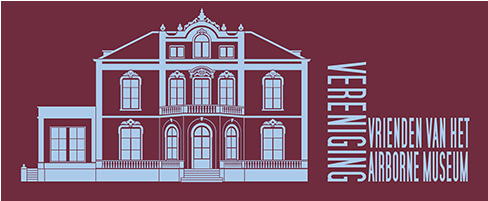
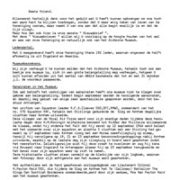
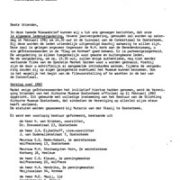
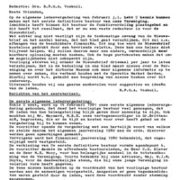
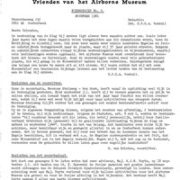
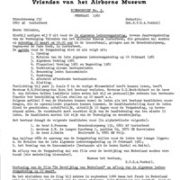
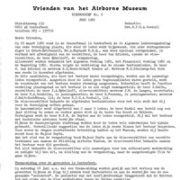
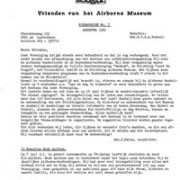
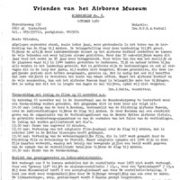
Plaats een Reactie
Vraag of reactie?Laat hier uw reactie achter.